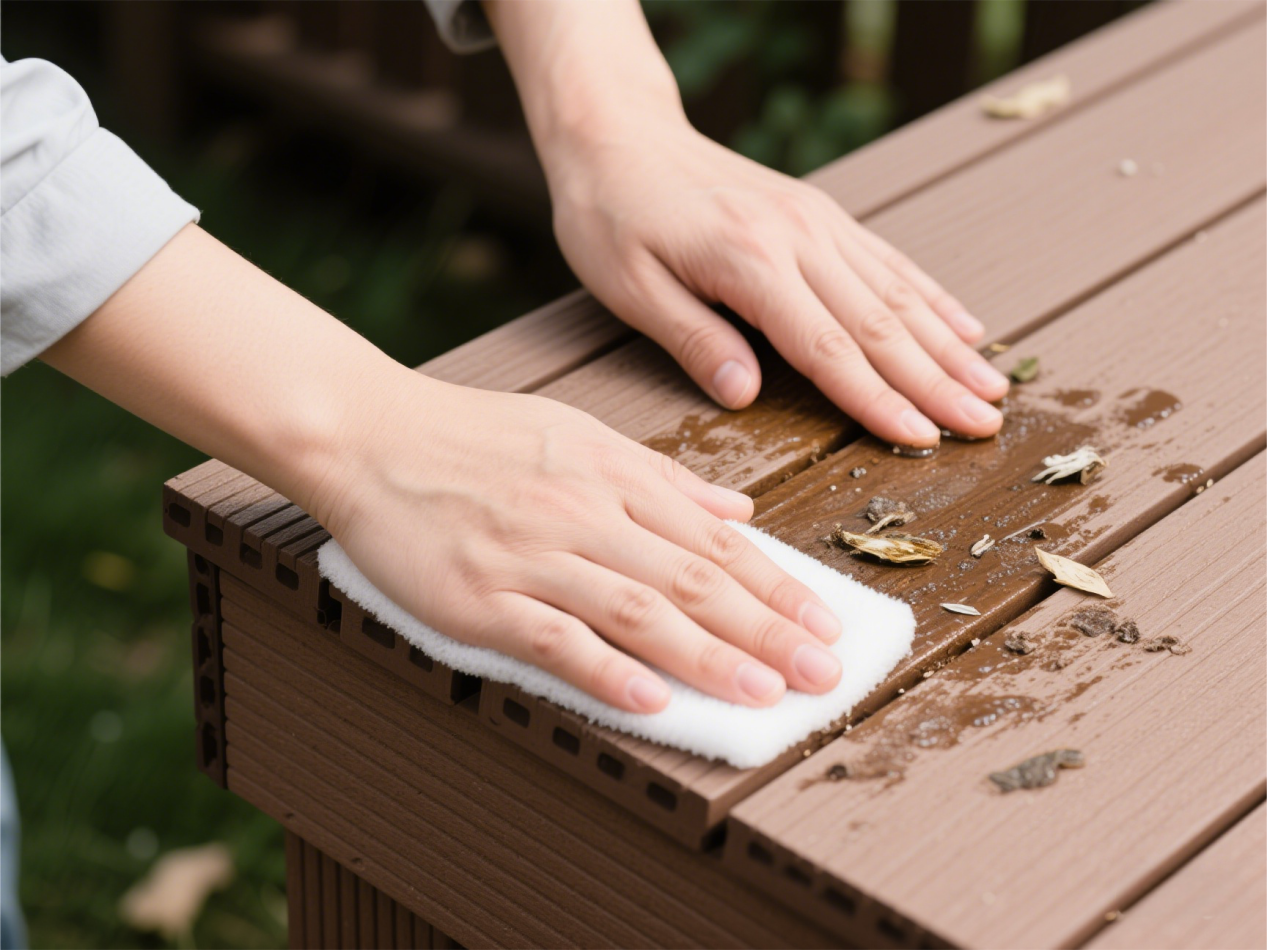News Center
Shandong Zhensure New Materials Technology Industry Co., Ltd.
I. Daily Cleaning: Three simple steps for easy maintenance
Remove surface debris
Use a soft-bristled broom or vacuum cleaner to regularly clean up dust, fallen leaves, etc., and avoid scratching with hard objects.
Gentle cleaning to avoid damage
For daily stains (such as footprints, dust), wipe with clean water or a neutral detergent (such as a diluted dishwashing liquid) and a soft cloth.
⚠️ Avoid: strong acid/alkali cleaners, bleach, hard tools such as steel wool balls.
Stubborn stain treatment: Oil stains, ink marks, etc. can be treated locally with a small amount of alcohol or a special wood-plastic cleaner, then rinsed with clean water and dried.Wood-plastic clean.png
Second, deep maintenance: Scientific protection to extend lifespan
Regular inspection and tightening
Check whether the connection points are loose every quarter, and reinforce the screws or clips in time to prevent deformation.
Sun protection and drainage maintenance
Install sunshades or choose light-colored products to reduce the impact of intense sun exposure. Make sure to leave a 5-10mm expansion joint during installation
to prevent water accumulation and expansion.
Anti-mold and anti-bacterial treatment
Damp environments are prone to mold growth. You can wipe with diluted bleach (in a ratio of 1:10) or use a dedicated anti-mold spray.
Iii. Common Problems and Solutions
Scratch repair: For minor scratches, gently sand with fine sandpaper (180-240 mesh) and then apply repair wax. Severe damage requires contact with a professional
service provider to replace the board.
Fading treatment: Choosing products with UV protective coatings can reduce the risk of fading. If it has faded, it can be solved by local painting or replacing the board.
Expansion deformation: Reserve expansion joints during installation to avoid thermal expansion and contraction compression. If it has occurred,
some of the plates need to be removed and the gap readjusted.
Iv. Why Choose Professional Wood-Plastic Cleaning and Maintenance?
Extending lifespan: Scientific maintenance can extend the service life of wood-plastic composites by more than 10 years, saving replacement costs.
Maintain beauty: Regularly clean to prevent stains from penetrating and keep the natural texture and color for a long time.
Environmental upgrade: Reduce the use of chemical cleaners, in line with the environmental protection concept of wood-plastic.
The charm of wood-plastic materials lies in their environmental friendliness and durability, and more importantly,
in the fact that through scientific cleaning and maintenance, every detail can radiate lasting vitality.
Whether it's a courtyard leisure area, a balcony view or a commercial space,
choosing wood-plastic means choosing a lifestyle that requires low maintenance and offers high enjoyment.I. Daily Cleaning: Three simple steps for easy maintenance
Remove surface debris
Use a soft-bristled broom or vacuum cleaner to regularly clean up dust, fallen leaves, etc., and avoid scratching with hard objects.
Gentle cleaning to avoid damage
For daily stains (such as footprints, dust), wipe with clean water or a neutral detergent (such as a diluted dishwashing liquid) and a soft cloth.
⚠️ Avoid: strong acid/alkali cleaners, bleach, hard tools such as steel wool balls.
Stubborn stain treatment: Oil stains, ink marks, etc. can be treated locally with a small amount of alcohol or a special wood-plastic cleaner, then rinsed with clean water and dried.

Second, deep maintenance: Scientific protection to extend lifespan
Regular inspection and tightening
Check whether the connection points are loose every quarter, and reinforce the screws or clips in time to prevent deformation.
Sun protection and drainage maintenance
Install sunshades or choose light-colored products to reduce the impact of intense sun exposure.
Make sure to leave a 5-10mm expansion joint during installation to prevent water accumulation and expansion.
Anti-mold and anti-bacterial treatment
Damp environments are prone to mold growth. You can wipe with diluted bleach (in a ratio of 1:10) or use a dedicated anti-mold spray.
Iii. Common Problems and Solutions
Scratch repair: For minor scratches, gently sand with fine sandpaper (180-240 mesh) and then apply repair wax.
Severe damage requires contact with a professional service provider to replace the board.
Fading treatment: Choosing products with UV protective coatings can reduce the risk of fading. If it has faded,
it can be solved by local painting or replacing the board.
Expansion deformation: Reserve expansion joints during installation to avoid thermal expansion and contraction compression.
If it has occurred, some of the plates need to be removed and the gap readjusted.
Iv. Why Choose Professional Wood-Plastic Cleaning and Maintenance?
Extending lifespan: Scientific maintenance can extend the service life of wood-plastic composites by more than 10 years, saving replacement costs.
Maintain beauty: Regularly clean to prevent stains from penetrating and keep the natural texture and color for a long time.
Environmental upgrade: Reduce the use of chemical cleaners, in line with the environmental protection concept of wood-plastic.
The charm of wood-plastic materials lies in their environmental friendliness and durability, and more importantly,
in the fact that through scientific cleaning and maintenance, every detail can radiate lasting vitality.
Whether it's a courtyard leisure area, a balcony view or a commercial space,
choosing wood-plastic means choosing a lifestyle that requires low maintenance and offers high enjoyment.
Installing WPC decking is renowned for its simplicity compared to traditional materials like ceramic tiles, offering significant time and cost savings.
Discovering that the edges of your artificial grass are lifting or peeling up can be a frustrating sight for any property owner or field manager.
When selecting WPC (Wood Plastic Composite) decking for a project, buyers are often faced with a fundamental choice right from the start
When selecting high-quality Artificial Grass, buyers often focus on the manufacturer’s reputation, product durability, and cost.
Artificial grass has become a premier choice for a multitude of applications, from expansive sports fields and football pitches to residential lawns and commercial landscaping.